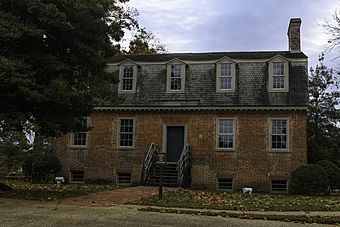Francis Land House facts for kids
|
Francis Land House
|
|

Francis Land House in December 2017
|
|
| Location | 3131 Virginia Beach Blvd. Virginia Beach, Virginia |
|---|---|
| Built | 1804 |
| Architect | Land, Francis |
| Architectural style | Georgian |
| NRHP reference No. | 75002118 100011852 (decrease) |
Quick facts for kids Significant dates |
|
| Added to NRHP | May 12, 1975 |
| Boundary decrease | May 19, 2025 |
The Francis Land House, also known as Rose Hall, is an old brick house in Virginia Beach, Virginia. It's found in the Rose Hall District. This house was once the main home of the important Land family. They were one of the first families to settle in Princess Anne County, Virginia.
Contents
History of the Francis Land House
The Land family lived on this land from the 1630s to the 1850s. The house was passed down through six men named Francis Land. After them, the last Francis's daughters owned it. Then, it was sold to another family.
Early Days and Land Ownership
The first Francis Land arrived in the area around 1638. By 1654, he owned about 1,020 acres of land. He got some of this land by bringing people with him to the area. Over the years, the plantation size changed. When the current house was built, the land was nearly 700 acres. Today, the house sits on 7 acres. It is now in a busy, commercial area.
Slaves were first recorded on the property in 1694. More slaves were brought in until the 1730s. By the mid-1700s, the plantation had as many as 20 slaves.
Building the House and Family Life
For a long time, people thought the house was built in 1732. But new research shows it was built between 1805 and 1810. Francis Land VI built the house. His family had lived on that land for 150 years before he built this home.
Francis VI and his family lived there from about 1805 to 1819. Francis VI had two daughters, Mary E. Land and Anne White Land. Mary married John Newton Walke. Anne married John Minson Galt in 1833. Mary and Anne kept the land until about 1850 or 1851. That's when it was first sold outside their family.
Changes Over the Years
In the early 1900s, Junius Thompson Sheets and his wife, Flora, bought the land. This included the Francis Land House. In 1912, the roof of the house was raised by 20 inches. Later, in 1929, their son sold the property to his sister, Jane (Jennie), and her husband, Raymond Garfield DeFrees.
During the 1930s, a large part of the property was lost. But the DeFrees family kept the main house and the land around it. They ran a dairy farm there until the mid-1950s. Raymond DeFrees was an engineer. He often traveled for his work. He also taught about astronomy. Many groups visited the house to learn from him.
Jennie DeFrees managed the dairy farm. She also raised their five children. During World War II, she oversaw German prisoners of war who worked on the farm. A large road was built nearby, and Naval Air Station Oceana opened. By the 1950s, new businesses started to appear. For some years, the house was even a dress shop called Rose Hall.
Becoming a Museum
In the early 1970s, a developer wanted to tear down the house. They planned to build a shopping mall. But the City of Virginia Beach stepped in. The city bought the house and 7 acres of land in 1975. Since 1986, it has been a historic house museum. The museum offers special programs for schools, Scouts, and the public. Next to the house are apartments and a professional center.
What the House Looks Like
The outside of the house is built in the Georgian style. Inside, you can see rooms that look like they did long ago. They have furniture from the Federal style and floors made of heart of pine wood. The outside walls are made of double-thick brickwork.
The grounds around the house are well-kept. There are different kinds of gardens, like herb, vegetable, and formal gardens. There's also a history park. It has a nature trail that is about 0.1 miles long. This trail goes through a wooded wetland. Along the trail, there are signs that explain things. The trail leads to what was once the Pine Tree Branch of the Lynnhaven River.
Historic Listings
The Francis Land House was added to the Virginia Landmarks Register in 1975. It was also listed on the US National Register of Historic Places in the same year. You might see a plaque that says it's on the "National Register of Historic Landmarks." However, it has not been given the special title of a National Historic Landmark.
See also
- List of the oldest buildings in Virginia
- National Register of Historic Places listings in Virginia Beach, Virginia



